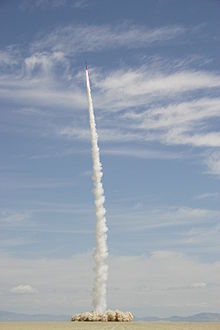- Civilian Space eXploration Team
-
The Civilian Space eXploration Team, known as CSXT, is a team of around 30 civilians interested in private spaceflight.[citation needed] The team was created by Ky Michaelson.[citation needed] It has conducted multiple rocket launches in an attempt to establish altitude records. CSXT claims to be the first entity to officially launch an amateur rocket into space.[citation needed]
Prior privately-funded space launches were achieved by the Orbital Sciences Pegasus, and many amateur teams have made unverified claims of rocket flights exceeding the boundary of space.[citation needed]
Contents
History
The team was established in 1995 by a group of model rocket hobbyists interested in spaceflight.[citation needed] The team is supported by corporate sponsorship.[citation needed]
Team Composition
Currently Ky Michaelson is the program director.[citation needed] CSXT's program is subdivided into three teams:
- Rocket Design and Ground Support Equipment
- Avionics and Ground System Design
- Wind Weighting System Development
Each team works together to design the rocket.[1]
The D.R. Hero Rocket
The D.R. Hero rocket was launched in August 1995.[citation needed] It was dedicated to stuntman Dar Robinson, a late friend of Ky Michaelson.[citation needed] The rocket was 18 feet (5 m) tall and 6 inches in diameter. It was anticipated to reach 100,000 feet (30,000 m). The actual launch height was not reported. This rocket failed in a large CATO (Catastrophe At Take Off) just above the ground.[1]
The Joe Boxer Space Launcher
Launched in August 1996 this rocket, was also 18 feet (5 m) tall and 6 inches in diameter.[citation needed] The name of the Rocket is attributed the largest contributing sponsor, Joe Boxer.[citation needed] It was anticipated to reach 70,000 feet (21,000 m), however, the actual height obtained was only 66,000 feet (20,100 m).[citation needed] The entire rocket was recovered after what was considered a successful flight. All of the rocket's systems functioned as intended and this was claimed to be the first amateur rocket to be recovered intact after reaching more than 50,000 feet (15,000 m).[2]
Space Shot - 1997
This slightly smaller rocket was 17 feet (5 m) tall and 6 inches in diameter, with an upper stage dart, only 3 or 4 inches across.[citation needed] It was the first two stage rocket launched by CSXT, and was expected to reach 400,000 feet (120,000 m).[citation needed] The rocket was a P 13,500 first stage as booster for a N motor upper stage.[citation needed] This would have been the largest high performance two stage flight in the history of hobby rocketry, beating by double the O 10,000 to M Kosdon flights.[citation needed] During the launch, an electronics failure prevented the ignition of the second stage, though the first stage successfully detached, and was recovered with a parachute.[citation needed]
Space Shot - 2000
This rocket was launched on September 29th, 2000 and was 15 feet (5 m) tall and 8.625 inches in diameter.[citation needed] It was expected to reach 60 nautical miles (110 km) with a maximum speed of 3,205 mph (5,158 km/h). After launch the rocket encountered problems at 45,000 feet (13,700 m) where the wind sheared off the fin causing the rocket to break apart. Although the launch was fairly unsuccessful, it did set a record for amateur rocket speed of 3,205 mph (5,158 km/h).[1]
Space Shot - 2002
This rocket was launched on September 21st, 2002. It was launched at the Black Rock Desert in Nevada.[1] The rocket was equipped with a solid-propellant motor.[citation needed] The motor was to launch the rocket into space in just 15 seconds, after obtaining speeds as fast as Mach 5.[citation needed] The rocket was equipped with GPS receivers and antennas, video recording devices, and a series of flight monitoring devices.[1] Three seconds after the rocket launched the motor burned through the casing causing the rocket to fail.[citation needed]
Space Shot 2004 "GoFast" Rocket
The rocket launched on Monday May 17, 2004.[1] The rocket was 21 feet (6 m) tall and 10 inches in diameter. This rocket was the first amateur rocket to exceed 100 kilometers or 62 miles, the official boundary of space.[citation needed] It was launched at the Black Rock Desert.[3] The team that built the rocket was estimated at about 25 people.[citation needed] The rocket reached 4,200 mph (6,800 km/h) in 10 seconds, and reached an estimated altitude of 72 miles (116 km).[citation needed] The avionics were recovered by deployment of a parachute.[4]
The final verified altitude was released as 72 miles (116 km).[5][6][7]
See also
References
- ^ a b c d e f Rocketman Enterprises (2005). CSXT: Civilian Space eXploration Team. Retrieved on 2007-01-27. http://www.the-rocketman.com/CSXT/default2.asp
- ^ Michaelson, Ky (2004). The ROCKETMAN and Joe Boxer Team Up. Retrieved on 2007-01-28. http://www.the-rocketman.com/boxerstory.html
- ^ Space Frontier Foundation (2007). Go "GoFast"! Space Frontier Foundation Congratulates First Amateur Team to Enter Space. Retrieved on 2007-01-27. http://www.space-frontier.org/PressReleases/2004/20040519gofastflight.html
- ^ ARRL Web: Ham Radio-Carrying Rocket Exceeds Goal; Avionics Recovered Intact (2004-05-20). Retrieved on 2007-01-28. http://www.arrl.org/news/stories/2004/05/19/1/?nc=1
- ^ Civilian Space eXploration Team (2005). GoFast Rocket Maximum Altitude Verification. http://www.ddeville.com/GoFast%20Maximum%20Altitude%20Press%20Release1.pdf
- ^ Lindsey, Clark, HobbySpace.com - Advanced Rocketry: Records, Achievements & Competitions, http://www.hobbyspace.com/Rocketry/Advanced/records.html, retrieved 2008-01-06
- ^ Wade, Mark, Astronautix - GoFast, http://www.astronautix.com/lvs/gofast.htm, retrieved 2008-10-22
External links
- High Altitude Amateur Rocket Records, HobbySpace.com (2004)
- Mystery Solved: Stratofox Recovers CSXT Booster, Stratofox Aerospace Tracking Team (2004)
- CSXT SpaceShot 2004 - First Amateur Launch to Space, Stratofox Aerospace Tracking Team (2004)
Categories:- Rocketry
- Unmanned spacecraft
- Private spaceflight
- Spaceflights
- Amateur radio
Wikimedia Foundation. 2010.


